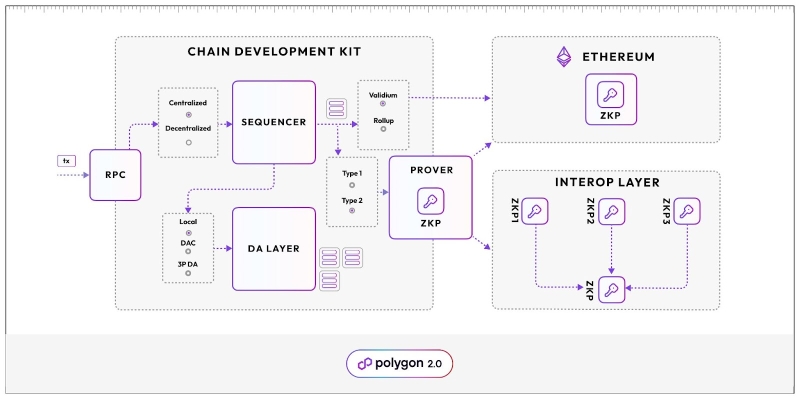
Following on the heels of the goals set with Polygon 2.0, the Polygon Labs team expands its presence even further in the world of Ethereum-based zk blockchains by launching the Chain Development Kit (CDK).
This is open source code for creating customizable and interoperable L2 chains with instant access to the unified liquidity of Ethereum and Polygon.
Developers can now rely on a convenient tool for creating interconnected modular blockchains.
Let’s look at all the details together.
Polygon “Chain Development Kit”: an open source code for creating interoperable Ethereum-based zk blockchains
With the ongoing success of the entire Ethereum-backed L2 blockchain landscape, the Polygon Labs team has decided to take a major step forward in the field of interoperability of its ecosystem with the Chain Development Kit (CDK).
This is an open source base code that developers can use to create modular zero-knowledge L2 networks that can be customized to certain requirements.
These chains will have a liquidity pool of $60-70 billion easily accessible between the Ethereum and Polygon ecosystems, as well as being tightly interoperable with each other.
The goals of the Polygon 2.0 project that promised unlimited scalability and unified liquidity are starting to become more and more a reality with this technological revolution.
How do we fix the “walled garden” issue in existing appchain ecosystems?
Until now, liquidity has either been fragmented, or these ecosystems are interoperable but saddled with friction.
Polygon CDK (Chain Development Kit) fixes this.https://t.co/Bq3HhOeg81 pic.twitter.com/LLDc7SVRtL
— Polygon (Labs) (@0xPolygonLabs) August 29, 2023
Existing layer-2 solutions on other decentralized ecosystems offer poor and isolated liquidity, with latent connections and additional security issues that make this niche of the Web3 inefficient and dangerous for the end user.
The Polygon Labs team, on the other hand, had long had in mind the idea of creating a set of layer 2 chains that take advantage of Ethereum’s security standard, all interconnected with each other and with the ability to tap into instant liquidity.
By connecting with a shared bridge, each L2 network will be able to exchange data with other infrastructures going to form the “value layer of the Internet.”
If we were to simplify this innovation, we could describe it as an evolution of the concept of supernet, in which it offered the possibility of managing sidechain-like appchain protocols leaning on the network before Polygon.
With The Chain Devolpment Kit the basic idea is the same but applied to zk-based layer 2 blockchains.
In this regard, all existing supernets can now upgrade and move to zk technology.
To ensure that this is possible there is a key technical component in this process, namely “the Polygon 2.0 interop Layer.” This protocol accepts zero-knowledge proofs from the Polygon ecosystem chains, aggregates them, and publishes the aggregated proof and updated states on Ethereum.
In this sense it can be perceived as a coordinator that ensures interoperability between zk networks and enables composability and unification of liquidity on a large scale.
The end result is instantaneous cross execution of transactions across layer 2s, regardless of mode (rollup or validium), execution environment and other configurations.
After this revolution, Polygon is changing all the cards in the Ethereum-based L2 blockchain industry and is poised to establish itself as the benchmark infrastructure for the coming years.

The state of the L2 market
As Polygon’s team launches CDK and experiments with new solutions that can improve the concepts of liquidity, scalability and interoperability in its ecosystem, the rest of the Ethereum-backed zk blockchain landscape is also improving step by step.
Lately layer-2 solutions seems to have become one of the dominant trends in the Web3 world of 2023, where every project, DAO, exchange or entity wants to launch its own layer-2 network that leverages zero-knowledge computational proofs.
In fact, if until a few months ago we could count on just the presence of Optimism, Arbitrum and a few other infrastructures, now the numbers are starting to take off with more and more and more success stories.
Since the launch of ZkSync Era in March we have seen a rapid expansion and introduction of new chains intended to replicate the same numbers as Matter Labs.
Among them we can count good results for Starknet, Linea, Mantle, and Polygon zkEVM.
In addition to the advantages offered by these infrastructures, with very fast transaction execution times and strong cost-effectiveness on the fee side, it is worth mentioning that much hype has been brought by the strong narratives inherent in the airdrop theme.
In fact, many of these networks do not feature a governance token and hint that they may launch one as they did for Arbitrum and Optimism, while at the same time pushing users to be as active as possible on the chain in order to be rewarded in the future.
Enriching this ever-expanding sector even more has been the advent of Base, a layer-2 blockchain of the Coinbase exchange, with the launch of the mainnet in August has reached staggering numbers creating a particularly high FOMO.
Many dApps are being built on this infrastructure, and already we can see extremely interesting protocols that will attract the attention of the web3 audience.
The Ethereum ecosystem is growing and increasingly becoming a place for every need, where there are a variety of decentralized solutions that the user can rely on.
The main problem will probably soon be that of competition as the offerings on the market are becoming so vast that they challenge the choices of both developers and users.
At the moment according to L2Beat data we can see a number of 29 L2 networks for a TVL of $9.76 billion.

